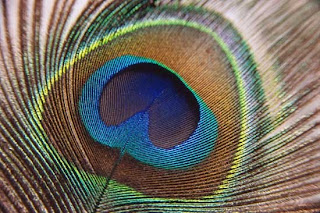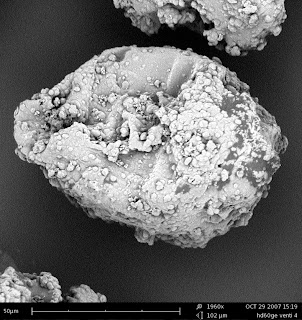coloration of a peacock feather
Now we know that the colorations of a peacock feather (and various other natural occurances) are caused by a nanoscale lattice work which reflects specific spectral wavelengths based upon its construction in relation fo the specific frequency of the wavelength. This structure is called a bio-photonic lattice.

barbules of a peacock feather
A) one barbule, B & C) lattice design of specific barbule, D) orientation of lattice strands
The way the change in color occurs is related to what is known as Bragg's Law, which shows how the distance between planes in the structure of a crystal affects light. Basically, the color which is reflected is due to the planes being half the distance of a specific color's wavelength apart from each other.
diagram of a Bragg reflection
This knowledge has been the basis for massive research in the area of photonic crystals and the synthetic manufacturing and manipulation of them. The most widely used applications of this are in the realm of one-dimension photonic crystals and can be seen in such things as dichroic glass. Pressing forward into two- and three-dimension photonic crystals has proven difficult due to costs of production and the scale of the work necessary.

Photonic lattice created at Sandia National Laboratories
The ability to "tune" the lattices to a specific frequency has been applied mainly to the field of optical communications. Scienceblog gives an excellent description of their history, "The most common idea for their use was based on their capability to transmit beams of light at selected frequencies and bend their paths without losing any energy. The structures, most often made out of silicon, consist of tiny bars fabricated to sit astride each other somewhat like Lincoln Logs at regular pre-set distances and angles that form in effect an artificial crystal. Spacing of the bars allows passage of only certain wavelengths; other wavelengths too big for the rafters, so to speak, cannot pass through. Desirable wavelengths not only pass through but also can be changed in direction by creating defects in the artificial crystal that cause the light to follow the defect along like a car passing through a curving tunnel. This meant photonic crystals had potential in optical communications, in which light beams currently carrying telephone messages and data must be converted to electrons -- an expensive process -- for certain tasks."
Shawn Lin at Sandia National Laboratories holds an early prototype of the photonic lattice as light passes through it. (Photo by Randy Montoya)
Recently, advances have been made to where the lattice can now operate in the infrared range - in effect trapping the wavelengths (unseen to human eyes) of heat. The idea occurred to construct this lattice of tungsten, a material which can handle high temperatures, which is ideally suited for collecting the infrared waves. The result is that the excited tungsten atoms, instead of melting the structure, reinforced emissions at higher wavelengths, in the visible frequency range. What does this mean?
Heat is converted to light.
Applications for this phenomena are already underway. One of the most obvious areas of interest would be applications which already involve the ues of tungsten, such as tungsten lightbulbs.
typical tungsten lightbulb
It is common knowledge that if someone touches a typical tungsten lightbulb after it has been on, there is a high likelihood of burning your skin. The inclusion of tungsten photonic lattices allows for advances in this type of lighting which has been used for decades. By producing the tungsten filament out of lattices tuned to the infrared frequency, not only will the heat be absorbed, but it will be re-emitted as even more light, producing a brighter, and more importantly cooler temperature light with a longer life.
filament of a tungsten lightbulb
Application to "Smart Wall System"
Now we arrive at a personal application of this knowledge. I am interested in the use of phase change materials in my wall system - for their thermal properties, as well as their optical properties. More research is needed into the concept I am formulating, but I believe I can constructively bring PCMs into interaction with photonic lattices.
Since the PCMs store latent heat differently during separate phases, the transmission and emission of heat is in flux depending on the amount present. If photonic lattices were incorporated into the PCM, or overlayed in a film, the various amount of infrared wavelengths could be transmitted through the lattice or trapped within it, re-emitting it to the degree which the lattice is tuned to. This could be many things, colors, light, or even electric current if photovoltaics are incorporated.
microencapsulated PCM. Photonic lattice could be incorporated into the PCM itself or the encapsultion medium.
Links:








No comments:
Post a Comment